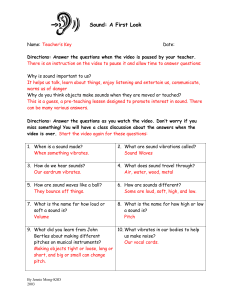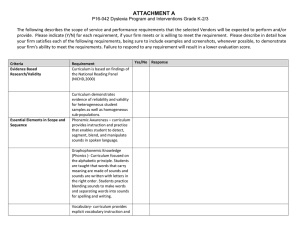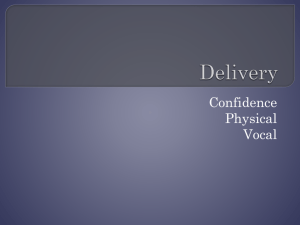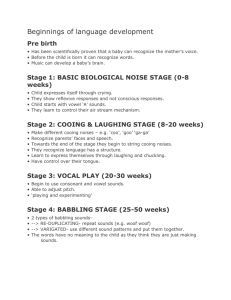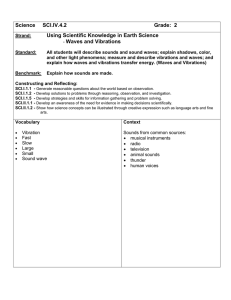Science SCI.IV.4.1
advertisement
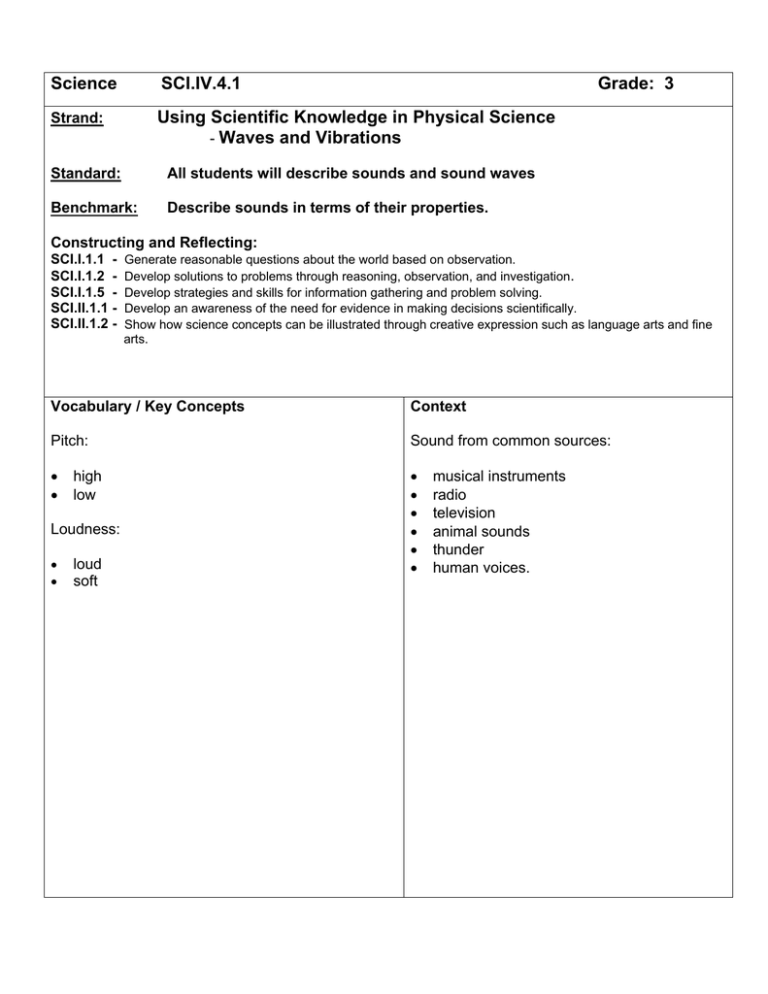
Science SCI.IV.4.1 Grade: 3 Strand: Using Scientific Knowledge in Physical Science - Waves and Vibrations Standard: All students will describe sounds and sound waves Benchmark: Describe sounds in terms of their properties. Constructing and Reflecting: SCI.I.1.1 SCI.I.1.2 SCI.I.1.5 SCI.II.1.1 SCI.II.1.2 - Generate reasonable questions about the world based on observation. Develop solutions to problems through reasoning, observation, and investigation. Develop strategies and skills for information gathering and problem solving. Develop an awareness of the need for evidence in making decisions scientifically. Show how science concepts can be illustrated through creative expression such as language arts and fine arts. Vocabulary / Key Concepts Context Pitch: Sound from common sources: • • • • • • • • high low Loudness: • • loud soft musical instruments radio television animal sounds thunder human voices. Knowledge and Skills Students will analyze and describe sounds in terms of their properties – pitch (high, low) and loudness (loud, soft). Resources Coloma Resources: Discover the Wonder - Grade 3 Module E – Chapter 1, pages 10-13 Other Resources: Nankivell, Sally. Science Experiments With Sound. Watts, 2000. Videoconferences Available For more information, see www.remc11.k12.mi.us/dl or call Janine Lim 471-7725x101 or email jlim@remc11.k12.mi.us 4.4.1 Sounds of Science from COSI Toledo (a science museum) Instruction Benchmark Question: What are the properties of sound? Focus Question: What are high and low pitch sounds? Students will: • • • • • Listen to, compare and describe the sounds from 3 or 4 different sized bells. Make straw whistles of varying lengths MEAP Investigation 1998 (link), and compare pitch to varying lengths. Create an instrument using glass bottles filled to varied heights of water, arrange them by pitch from high to low and try to play a song. Discuss which items produce high and low pitch. Make high and low pitched sounds with their voices. Assessment Coloma Assessment: Discover the Wonder – Grade 3 Module E, page 23 Other Assessment: Students in groups will be part of a band. They will each construct an instrument. They will play a recognizable tune to an invited audience. Each student will identify their instrument and explain what it can do, demonstrating the volume and pitch. In the explanation, they will explain how different pitches can be made. After each student has described their instrument, the group will play their song. * It is recommend that the assessment for this Benchmark and Benchmark IV. 4. E. 2. be used for a culminating assessment for a sound unit. (Give students rubric before activity.) Scoring Rubric Criteria Apprentice Basic Meets Exceeds Effectiveness of construction Constructs an instrument that does not produce a sound. Constructs an instrument that produces a sound with one pitch. Constructs an instrument that produces a sound with two different pitches. Constructs an instrument that produces a sound with three or more different pitches. Accuracy of explanation Explains how the instrument works without using the concepts of pitch and loudness. Explains how the instrument works using the concepts of pitch or loudness. Explains how the instrument works using the concepts of pitch and loudness. Explains how the instrument works using the concepts of pitch and loudness plus explains that sounds are produced through vibrations. Effectiveness Produces a of performance noise instead of a song. Performs an unrecognizabl e song. Performs a recognizable song with some mistakes. Performs a recognizable song with no mistakes. Teacher Notes: Describe sounds and sound waves. During the elementary grades, children should begin to describe and analyze their rich experiences with sounds. In particular, they should be able to distinguish sounds from the objects that make them. They need to understand that sounds exist in the air, and that they are separate from the objects that make them. Elementary students should learn that all sounds originate with some kind of vibrating object or substance. As middle school students experience sound traveling through different media; they should identify other ways that matter can affect sound. Many students think of echoes only as sounds that repeat themselves in open spaces. They do not relate them to the movement of sound waves, nor do they understand that echoes are produced whenever sound waves bounce back (reflect) off large surfaces.
